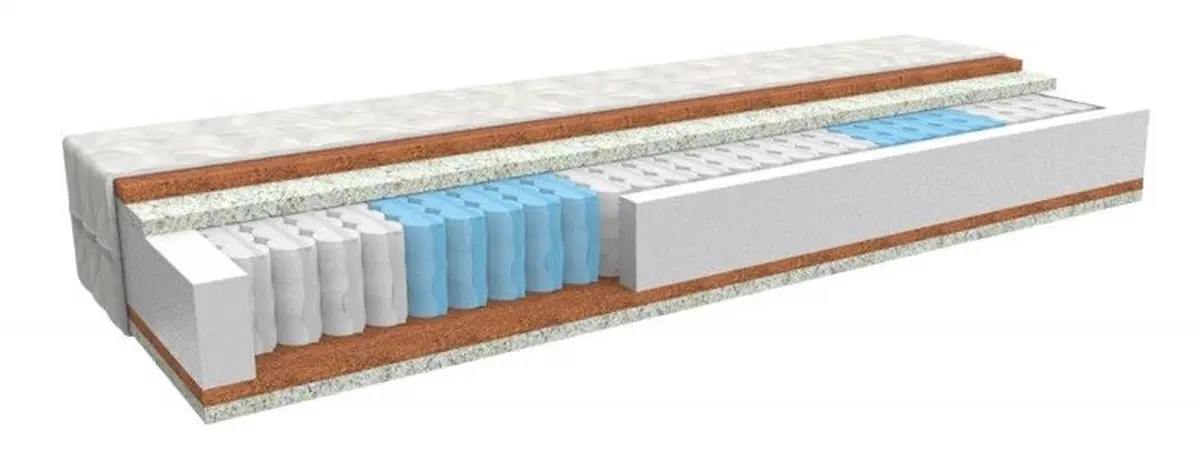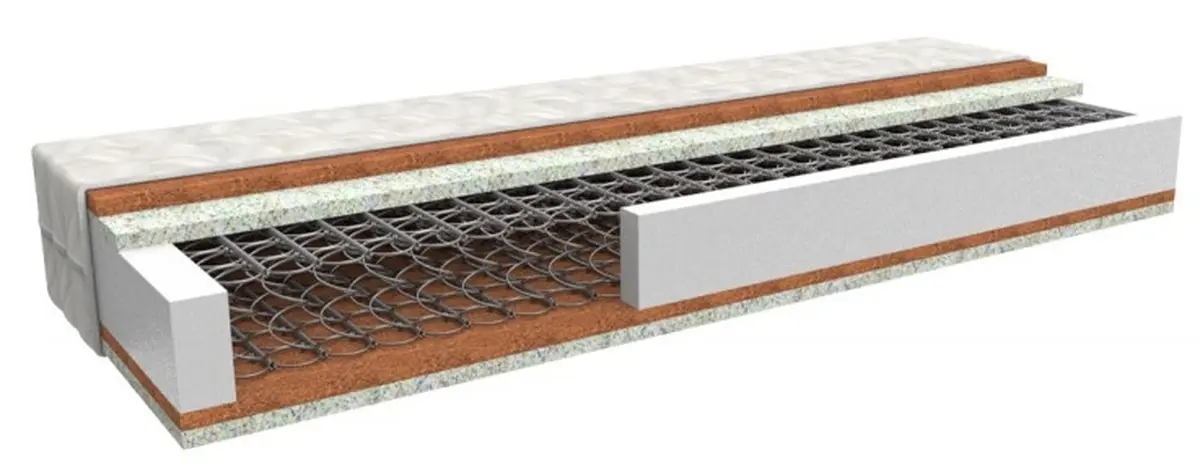Spring mattresses
Spring mattresses are among the traditional and widespread types of mattresses that have been used in households for decades. Although modern technology has brought alternative materials such as memory foam or latex, spring mattresses still retain their popularity due to their unique features, benefits and wide availability. This text discusses in detail the different types of spring mattresses, their structure, advantages and disadvantages, durability, health effects, as well as recommendations for selection and care.

The  trade mark POTEMA® defines the branded technology concept of a professionally qualified Carpet Service® implementation company dedicated to the regular maintenance, cleaning, disinfection, impregnation of synthetic, natural, wool, silk and American-made mattresses, beds and textiles. This branded concept delivers the utmost professionalism in full synergy with maintaining ethical, environmental and quality performance standards, including a contractual guarantee of contractor services.
trade mark POTEMA® defines the branded technology concept of a professionally qualified Carpet Service® implementation company dedicated to the regular maintenance, cleaning, disinfection, impregnation of synthetic, natural, wool, silk and American-made mattresses, beds and textiles. This branded concept delivers the utmost professionalism in full synergy with maintaining ethical, environmental and quality performance standards, including a contractual guarantee of contractor services.
Spring mattresses offer a combination of traditional construction with modern benefits and can be a great choice for a wide range of users. With different types of spring systems such as bonell, pocket and micro pocket springs, there is a mattress to suit different preferences in firmness, comfort and price budget. However, it is important to consider individual comfort requirements, spinal support and sleep position preferences before purchasing a spring mattress.
History of spring mattresses
The first references to the use of spring systems in furniture date back to the 19th century. Springs were originally developed as an innovation for armchairs and sofas to provide comfort and support. Over time, springs began to be integrated into mattresses as well, revolutionizing sleep comfort. Classic spring mattresses became the standard for beds around the world, as they not only provided comfort, but also the ability to properly support the spine and provide optimal air ventilation.
The development of spring mattresses didn’t stand still, and as the decades passed, new technologies such as pocket springs came along to provide even better fit and separate support for different parts of the body. Today’s spring mattresses use the latest materials and construction to meet the demanding requirements for a healthy and comfortable sleep.
Types of spring mattresses
Spring mattresses are not just one type of mattress. There are different types of spring systems that vary in construction, materials and resulting comfort. Here we take a look at the most common ones.
Bonell springs
Bonell springs are the oldest and most common type of spring system. The springs are hourglass-shaped and connected by wires, which means that when one spring is loaded, the surrounding springs are also affected. This type of spring core is often used in cheaper mattresses. Bonell springs are known for their strength and longevity, but the downside is less ability to conform to the body and poorer isolation of movement.
Plate springs
Target springs are a more modern version of the spring system that provides greater comfort and better adaptation to the body. Here, each spring is housed in a separate fabric bag, meaning the springs can move independently of each other. This type of mattress better supports the body and provides better isolation of movement, which will be especially appreciated by partners who have different sleeping habits. The independence of the individual springs also means there is less risk of bedsores.
Microcot springs
Micro-plate springs are a new addition to the mattress market and offer even softer and more precise support. This type of mattress contains thousands of tiny springs in separate fabric pouches, ensuring an extremely detailed following of the body contours and a higher level of comfort. Micro-plate springs are typically used in more luxurious mattresses, where they are combined with other materials such as memory foam or latex for maximum comfort.

Benefits of spring mattresses
Spring mattresses have many features that make them attractive to a wide range of users. The main benefits include:
Excellent ventilation
Thanks to the open spring system, spring mattresses are highly breathable, which helps regulate temperature during sleep. This feature is useful for people who tend to sweat during the night or live in warmer climates.
Stable body support
Spring mattresses provide firm and stable support that helps keep the spine in the correct position. This is especially important for people with spinal problems or those who need a firmer base for their sleep. Especially the pocket springs provide optimal support for the different parts of the body.
Long life
Quality spring mattresses are known for their long life, which means that you can use them for many years without a significant decrease in comfort. The materials used for the springs, such as steel, ensure the mattress is strong and durable.
Wide availability and price range
Spring mattresses are one of the most widely used types of mattresses and are therefore available in a wide range of prices and sizes. This means you can choose a mattress to suit any budget, which is convenient for everyone.
Disadvantages of spring mattresses
Despite the many advantages, spring mattresses have some disadvantages that prospective buyers should consider before making a purchase:
Noise
Spring mattresses can make noises when they move, which can be disturbing when sleeping, especially if you are sleeping with a partner. Noise is usually an issue with cheaper mattresses with bonell springs, while modern pocket springs are quieter.
Less adaptability
Unlike memory foam or latex mattresses, innerspring mattresses can offer a lower level of conformability to the body. Bonell springs typically do not offer enough follow the shape of the body, which can be a disadvantage for people with joint or back pain.
Risk of pressure ulcers
Spring mattresses with a lower spring density or a Bonell core may lose shape and comfort over time. This can lead to pressure sores, especially if the mattress is not rotated regularly.
Higher weight
Spring mattresses are typically heavier than mattresses made of foam materials, which can make them difficult to move or maintain.

Choosing a spring mattress: what to look out for
If you’re considering a spring mattress, it’s important to consider a few key factors to ensure the mattress best suits your needs.
Type of spring system
As mentioned, there are different types of spring systems, each offering different features. Bonell springs are suitable for those looking for a firm base at a reasonable price, while pocket and micro pocket springs are suitable for those who prefer a better fit to the body and increased comfort.
Mattress firmness
Mattresses are sold in different firmness levels, from soft to very firm. The firmness of the mattress is a key factor for comfort and body support. In general, the more you weigh, the firmer the mattress you will need. The firmness should also be chosen with your preferred sleeping position in mind.
Quality of materials
The quality of the materials used to make the mattress is an important factor, as these have a direct impact on durability and comfort. High quality springs and fillings ensure long-lasting support and comfort, while cheaper materials can quickly become deformed.
Health certification
Many manufacturers offer mattresses with health certifications that confirm suitability for people with allergies or specific health needs. Certifications such as OEKO-TEX or CertiPUR guarantee that the mattress is free of harmful chemicals or allergens.

Cleaning and regular disinfection of mattresses
The mattress is one of the most important elements of our home, having a major impact on our health, well-being and quality of sleep. When choosing a mattress, we pay close attention to its material, hardness and ability to adapt to the shape of the body. Unfortunately, we often forget that we also need to care for and clean the mattress regularly. Although many people don’t realise it, a mattress can become an ideal environment for dust mites, bacteria, mould and other dirt. In this text, we’ll explain why regular mattress cleaning is important, what your options are, and how to choose the best mattress cleaner.
Mattress Vacuuming & Knocking: Professional vacuums with a HEPA filter and HEPA bag must have an electric vibrating knocking head. This technology of KIRBY® / HYLA® vacuum cleaners makes it possible to remove surface mold spores, dust mites by dry method from the mattress surface.
Cleaning with special chemical cleaners: Profesionální antibakteriální dezinfekční prostředky a čističe výrobce a značky POTEMA® / Dr. Schutz® přináší ekologicky šetrný antialergenní způsob dezinfekční údržby povrchu matrací.
UV-C Lamp: We recommend entrusting your mattress to industry professionals who have a UV-C germicidal mattress lamp. UV lamps that produce UVC radiation are designed to be safely used on mattress surfaces and other household items. The radiant energy of the UVC radiation acts directly on microorganisms that reside on the surface and top layer of the mattress. The disinfection process usually takes several minutes, during which time the lamp kills up to 99.9% of the bacteria and other harmful organisms present.
OZON: we recommend entrusting your mattress to industry professionals who have the BIO-OZON® vacuum cleaning system. The disinfecting properties of ozone result from its ability to oxidize molecules in the cells of bacteria, viruses and other microorganisms. When ozone comes into contact with these pathogens, it disrupts the cell membrane or wall of the microorganism, leading to its decomposition and subsequent death. This process works similarly to the action of conventional disinfectants, but without the use of chemicals, which is beneficial for people who prefer natural and eco-friendly solutions.
In indoor applications such as mattress cleaning, ozone not only kills bacteria and viruses, but also mites, mold spores and other allergens. Its ability to destroy harmful microorganisms without toxic residues makes it ideal for the environment in which we sleep and rest.
Allergens, mold spores, bacteria, viruses and dust mites are not only a hygiene problem in mattresses, but also a health problem. But with proper prevention, maintenance and the right choice of mattress, the risks can be significantly reduced. Even the thickest sheets and blankets cannot protect us from micro-particles. Dust mites or moulds, which often number up to one million and produce allergy-causing faeces that settle in our mouths, noses, eyes, etc. every time we move. In addition to the allergy manifesting as itching, mucous membrane inflammation, bronchitis, asthma and shortness of breath can be added. This condition can be prevented by professional cleaning and deep dry disinfection thanks to UV-C radiation or vacuum ozonation of the mattress with thorough machine vacuuming and above all regular maintenance.